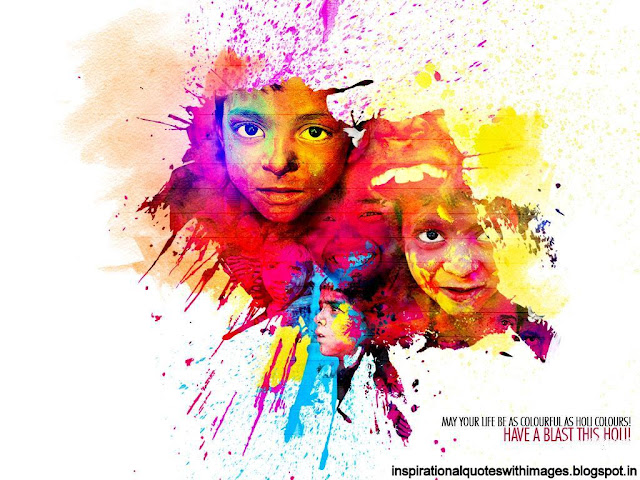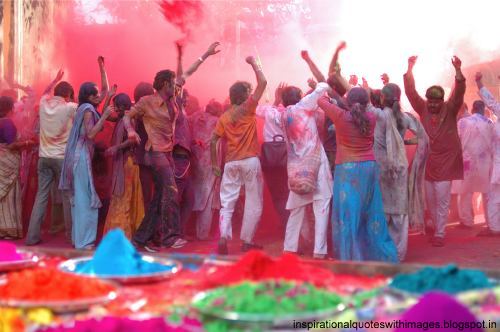Holi Festival In India
Holi comes from the word "Holika", the sister of Hiranyakashipu. The festival of Holi is celebrated because of a history in the ancient Hindu religion. In Vaishnavism, Hiranyakashipu is the great king of demons, and he had obtained a boon by Brahma, which made it almost impossible for him to be killed. The boon was due to his long penance, after which he asked that he not be killed "during day or night, indoors or outside, not on earth or in heaven, neither by man nor animal, neither by astra nor by shastra ". Consequently, he grew arrogant and attacked the Heavens and the Earth. He demanded that people stop worshiping Gods and start praising him respectfully
Celebration Of Holi In India
Hiranyakashipu, on his knees, getting killed by Narasimha, an incarnation of Vishnu. According to this belief, Hiranyakashipu's own son, Prahlada, was a devotee of Vishnu. In spite of several threats from Hiranyakashipu, Prahlada continued offering prayers to Lord Vishnu. He was poisoned by Hiranyakashipu, but the poison turned to nectar in his mouth. He was sentenced to be trampled by elephants yet remained unharmed. He was put in a room with hungry, poisonous snakes and survived. All attempts Hiranyakashipu to kill his son failed. Finally, he ordered young Prahlada to sit on a pyre on the lap of Holika, Hiranyakashipu's sister demon, who also could not die because she had a boon in preventing it from being burned by the fire. Prahlada readily accepted his father's orders, and prayed to Lord Vishnu to keep him safe. When the fire started, everyone watched in amazement as Holika burnt to death, while Prahlada survived unharmed. The salvation of Prahlada and burning of Holika is celebrated as Holi. At Mathura, where Krishna grew up, the festival is celebrated for 16 days (until Rangpanchmi) in commemoration of the divine love of Radha for Krishna. The celebrations officially usher in spring, the celebrated season of love
Holi In India
Radha and the Gopis celebrating Holi, with accompaniment of musical instruments each year thousands of Hindus participate in the festival of Holi. The festival has many purposes. Firstly, it celebrates the beginning of the new season, spring. Originally, it was a holiday that commemorates harvests and fertile land. Hindus believe that it is a time to enjoy abundant colors of spring and say goodbye to the winter. It also has a religious purpose, commemorating the events in Hindu mythology. Even if it is the religious festival, this is probably one of the most exciting existence. During this event, participants hold a bonfire, throw colored powder at each other, and celebrate wildly. Rangapanchami occurs a few days later on a Panchami (fifth day of the full moon), marking the end of festivities involving colors. The main day, Holi, also known as Dhuli in Sanskrit or Dhulheti, or Dhulandi Dhulendi, is celebrated by people throwing scented powder and perfume to another. The bonfires are lit on the eve of the festival, also known as Holika Dahan (burning of Holika) or Chhoti Holi (little Holi), then Holika Dahan prayers are said and praise is offered. The bonfires are lit in memory of the miraculous escape that young Prahlad accomplished when Demoness Holika, sister of Hiranyakashipu, carried him into the fire. Holika was burnt but Prahlad, a staunch devotee of god Vishnu, escaped without injury due to his devotion. Holika Dahan is called Kama Dahanam in South India.
Holi is celebrated at the end of the winter season on the last full moon day of the lunar month Phalguna (February / March), (Phalgun Purnima), which usually falls in the later part of February or March. In 2009, Holi ('Dhulandi ") was on March 11 and Holika Dahan was on March 10. In 2010, Holi was on March 1 and Holika Dahan was on February 28. In 2011, Holi was on March 20 and Holika Dahan was on March 19. In 2012, Holi was on March 8. In most regions, Holi lasts about two days. Holi decreases (but does not completely eliminate) the strict social norms which includes differences in age, sex, status, and caste. Together, rich and poor, men and women, enjoy each other's presence that day. Nobody expects politeness, so the atmosphere is filled with excitement, fun and joy.
Although there have been references in Sanskrit texts of similar festivals as Ratnavali where people sprayed colored waters using bamboo syringes, the origin of the modern Holi festival has been traced to ancient Bengal . It was a Gaudiya Vaishnav festival, in accordance with Vaishnaviya Tantra. People went to Krishna temple, applied red color to the icon and then distributed the red powder or Abir malpua prasad with family and friends. Red means the color of passion and Lord Krishna is the king of desires. The ritual signified that all our desires should be diverted for the attainment of Krishna and for the well-being of society.
In some cultures, however, the ritual of burning wood and leaves on the full moon night already existed. This ritual was to signify the end of winter and full advent of spring. Old wood and fallen leaves were burnt to signify that it was time for new leaves and flowers. People then spread their bodies with ash. Later, however, the story of Holika Dahan has been associated with this ritual
Celebrate holi with more colors here




